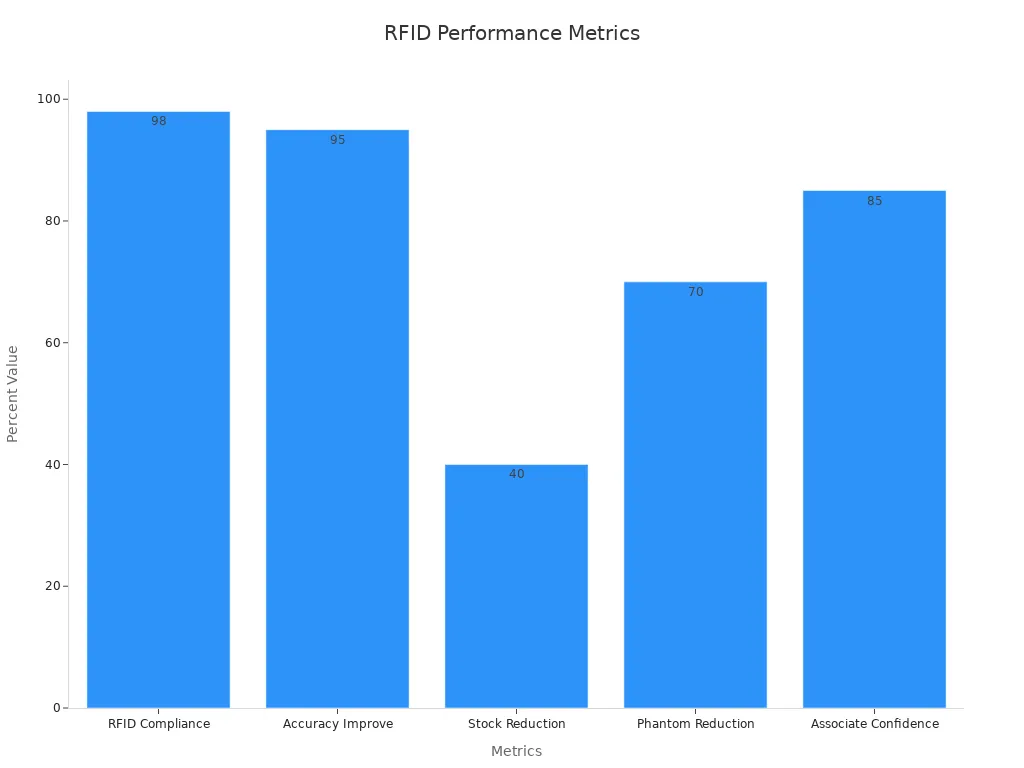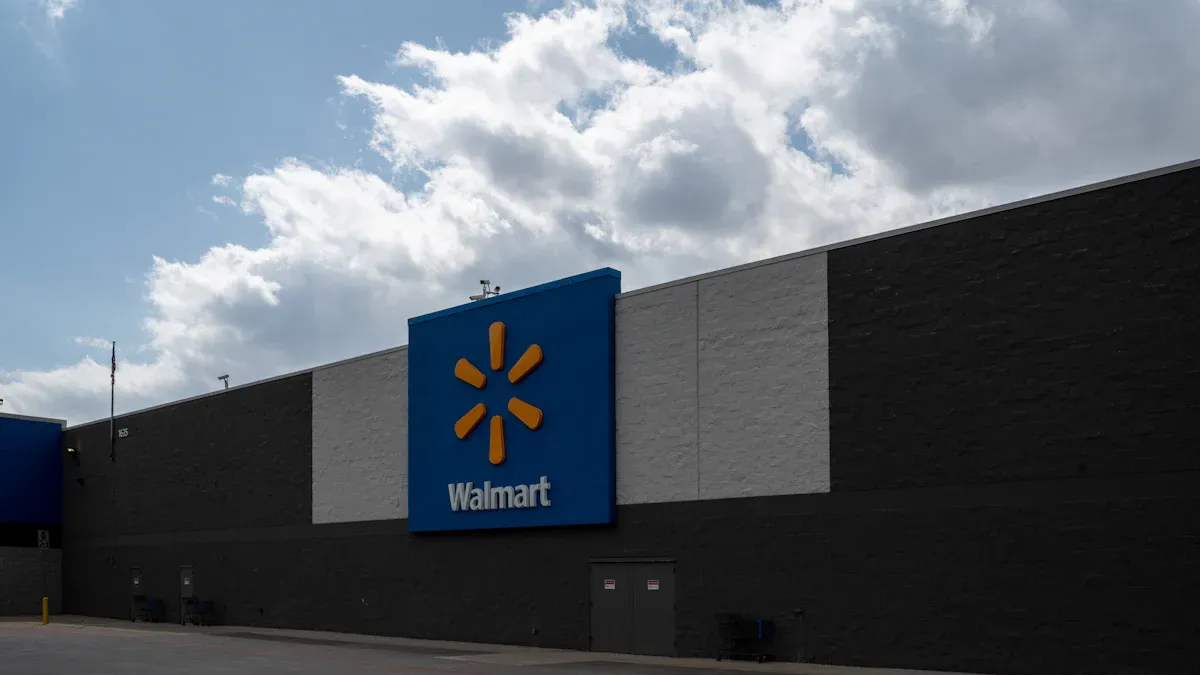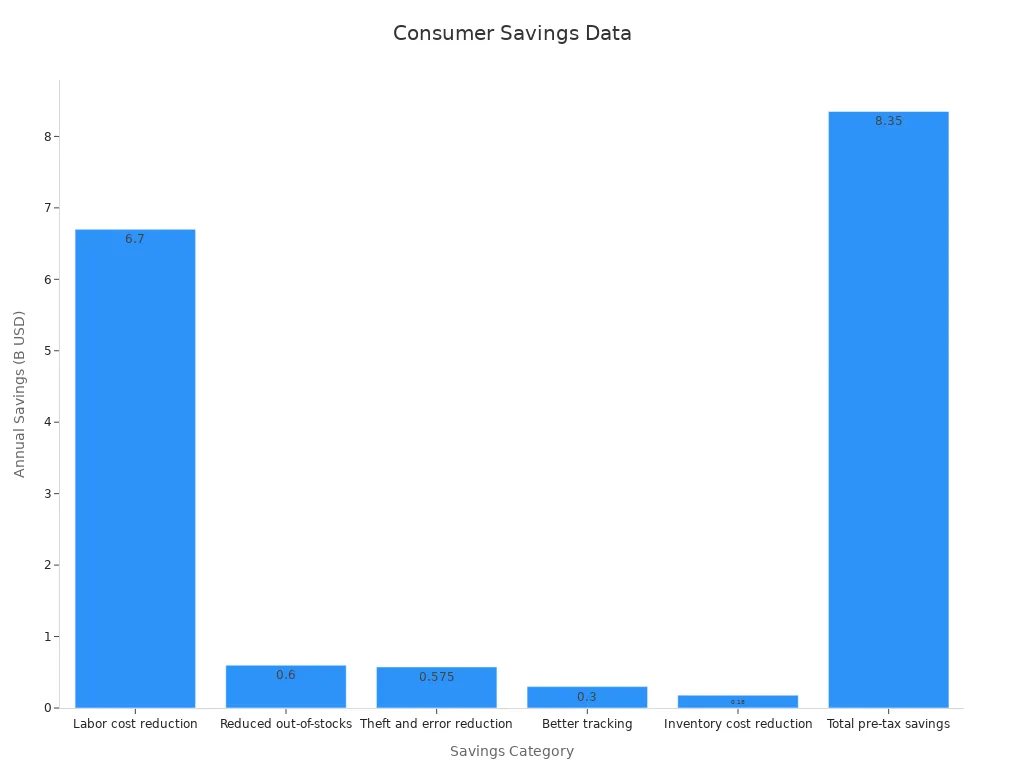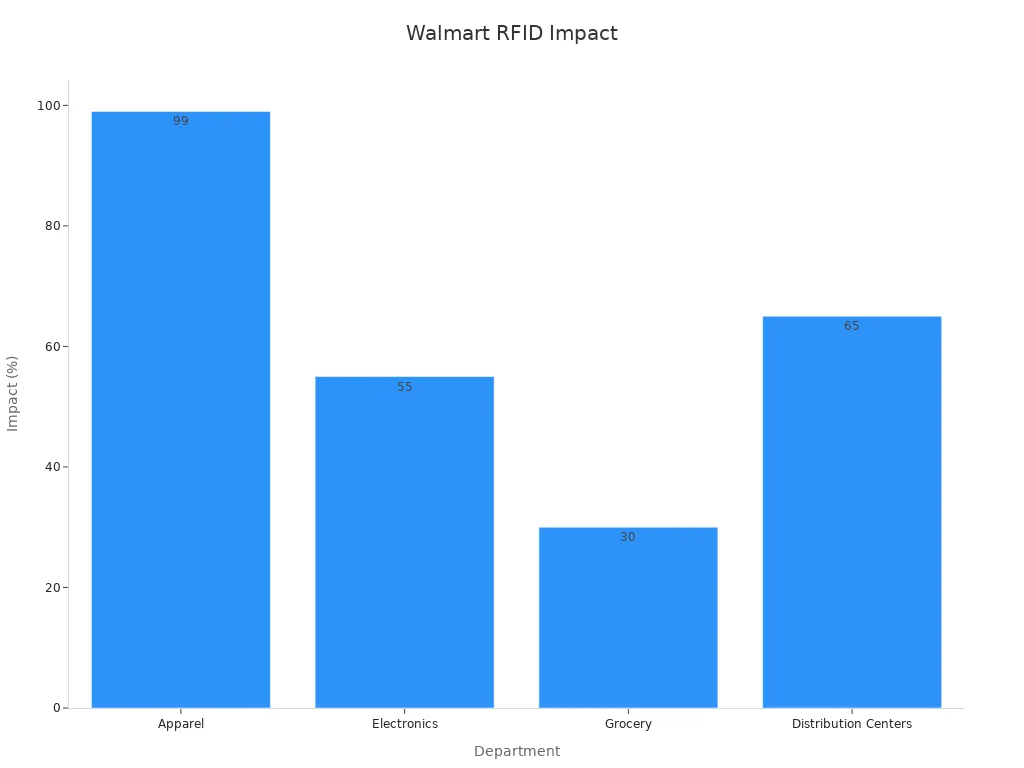
You benefit from Walmart’s electronic tags in 2025 because they deliver faster price updates and greater product availability. When you shop, you see more accurate pricing through Electronic Shelf Labels and ESL Price Tag displays, powered by the ESL Gateway AP. Walmart’s RFID system in Esl Retail stores reduces out-of-stock items by 16% and replenishes shelves three times faster than traditional bar-code methods. This technology makes your shopping experience smoother and helps Walmart operate more efficiently.
What Are Walmart’s Electronic Tags?

How Digital Price Tags Work
Display Technology
You see digital shelf labels throughout Walmart stores. These labels use e-ink or LCD screens to show prices, product names, and barcodes. The screens offer high contrast and clear visibility from different angles, making it easy for you to read prices. Digital shelf labels connect wirelessly to Walmart’s central pricing system. This connection ensures that every price you see matches the latest updates from Walmart’s headquarters.
Real-Time Price Updates
You benefit from real-time price updates with digital price tags. When Walmart changes a price in its system, the update appears instantly on the shelf. This process eliminates delays and reduces errors that often occur with manual price changes. You always see the most accurate price, which supports Walmart’s commitment to price transparency and consistency.
The Role of RFID Tags in Walmart’s System
RFID Integration
Walmart’s electronic tags rely on advanced RFID systems. You encounter RFID tags on products and shelves, which allow for automated tracking and inventory management. The Walmart RFID mandate requires suppliers to use certified RFID tags that meet strict standards for readability and data structure. Walmart partners with Auburn University’s RFID Laboratory to ensure tag quality and system reliability. The RFID system includes thousands of reader portals, handheld readers, and even RFID-enabled robots and smart shelves.
| Specification / Metric | Details / Values |
|---|---|
| RFID Tag Compliance Rate | Suppliers must maintain 98% compliance |
| Hardware Components | Over 5,000 RFID reader portals at distribution centers |
| More than 10,000 handheld RFID readers in stores | |
| RFID-enabled inventory robots in select locations | |
| Smart shelves with integrated RFID capabilities (testing phase) | |
| Inventory Accuracy Improvement | Increased from 63% pre-RFID to over 95% post-implementation |
| Out-of-Stock Reduction | 40% reduction in RFID-enabled departments |
| Phantom Inventory Reduction | 70% reduction |
| Loss Prevention Features | Real-time tracking of high-value items |
| Automated alerts for unauthorized item movement | |
| Software Infrastructure | Custom RFID middleware and cloud-based data lakes |

Benefits of RFID Technology
You experience fewer out-of-stock items and more accurate inventory thanks to RFID technology. RFID tags enable real-time monitoring, which improves inventory accuracy from 63% to over 95%. The system reduces out-of-stock situations by 40% and phantom inventory by 70%. RFID systems also support loss prevention by tracking high-value items and sending automated alerts for unauthorized movement. You benefit from a more reliable shopping experience and better product availability.
Walmart’s Motivation for Adopting Digital Price Tags
Operational Goals
Walmart’s electronic tags support the company’s operational goals. You expect low prices and high product availability. Walmart uses digital shelf labels and RFID systems to deliver on these expectations. The Walmart RFID mandate ensures suppliers follow best practices, which improves inventory accuracy and reduces manual errors. Walmart’s focus on everyday low prices and efficient supply chain management drives the adoption of these technologies.
| Aspect | Evidence Summary |
|---|---|
| Pricing Strategy | Focus on Everyday Low Prices (EDLP) and cost leadership. |
| Supply Chain Management | Modern distribution strategies and SKU systems. |
| IT Systems | Investment in advanced tracking and delivery systems. |
| Customer Experience | Accurate, competitive pricing and convenience. |
| Implication for Digital Tags | Real-time price and inventory management to reduce manual updates and improve price accuracy. |
Implementation Timeline
You see Walmart’s digital shelf labels and RFID systems expanding rapidly. The company began with pilot programs and now rolls out these technologies across more stores each year. Walmart’s RFID mandate for suppliers continues to evolve, requiring higher compliance and broader adoption. You can expect even more stores to feature digital price tags and RFID-enabled inventory management by the end of 2025.
Pricing Breakdown of Walmart’s Electronic Tags
Initial Investment for Digital Price Tags
Hardware and Installation Costs
When you consider the initial investment for Walmart’s electronic tags, you see a significant outlay for hardware and installation. Each high-resolution display costs between $10,000 and $15,000 per unit. These displays offer energy efficiency and high clarity, which supports clear pricing and product information. Installation costs range from $2,000 to $5,000 per location, depending on store size and local regulations. You also need to account for media player hardware, which requires a one-time purchase of $150 per device. Mounting solutions add another $20 to $100+ per display, depending on the type you select.
| Cost Component | Estimated Cost Range | Key Considerations |
|---|---|---|
| High-Resolution Displays | $10,000 – $15,000 per unit | Energy-efficient, high clarity for indoor ads |
| Installation Costs | $2,000 – $5,000 per location | Varies by site complexity and regulations |
| Media Player Hardware | $150 per device | One-time purchase |
| Mounting Solutions | $20 – $100+ per display | Depends on mounting type |
Software and Integration Fees
You must also budget for software licensing and integration. Monthly software licensing fees range from $29 per license, or $25 per license if billed annually. These fees cover content management and dynamic updates for digital price tags. Integration with Walmart’s rfid and point-of-sale systems requires technical expertise and additional investment. Insurance coverage for equipment and liability protection starts at $1,000 annually.
Ongoing Maintenance and Support
Battery Replacement and Upkeep
You benefit from long battery life in rfid-enabled digital price tags. Batteries last up to five years, which reduces the frequency of replacements. Maintenance contracts from vendors help you manage predictable support costs. These contracts usually cost less than the ongoing labor required for traditional tags.
Software Updates and Technical Support
You need regular software updates to keep your rfid and pricing systems secure and efficient. Vendors provide technical support as part of maintenance contracts. Centralized updates and scalable management reduce compliance risks and labor costs, especially in large-scale deployments. Smaller retailers may face more challenges with maintenance and technical demands, but Walmart’s scale helps offset these issues.
Tip: You can expect a 95% reduction in labor time for price updates after implementing electronic shelf labels. This efficiency leads to significant operational savings.
Hidden and Additional Fees
Licensing and Subscription Costs
You should not overlook ongoing licensing and subscription costs. Software licensing fees, as mentioned, are recurring. You may also face additional charges for advanced rfid integration or premium support.
Upgrade and Replacement Charges
You encounter upgrade and replacement charges over time. As technology evolves, you may need to replace displays or rfid components. Insurance, disposal, and removal fees can also add to your total cost. For example, if you use Walmart Fulfillment Services, you pay storage fees ranging from $0.75 to $1.50 per cubic foot per month, depending on the season. Returns processing and fulfillment fees depend on item weight and category, which can impact your overall pricing strategy.
| Fee Type | Details / Numerical Data |
|---|---|
| Returns Processing Fees | $4.70 (up to 1 lb), $6.20 (up to 2 lbs), $6.70 (up to 3 lbs), $7.00 + $0.40/lb (4-20 lbs) |
| Fulfillment Fees (WFS) | $3.45 (up to 1 lb), $4.95 (up to 2 lbs), $5.45 (up to 3 lbs), higher for bulky items |
| Storage Fees (WFS) | $0.75/cubic foot (Jan-Sep), $1.50/cubic foot (Oct-Dec, >30 days) |
| Referral Fees | 5%-15% of selling price, varies by category |
| Other Fees | Problem inventory, disposal, removal, and advertising costs |
You need to factor in these hidden and additional fees when evaluating the total cost of Walmart’s rfid and digital price tags system. These costs influence your long-term pricing and operational decisions.
Cost-Effectiveness of Digital Price Tags vs. Traditional Tags
Upfront Costs Compared to Paper Tags
Initial Outlay Differences
When you compare digital shelf labels to traditional paper tags, you notice a clear difference in upfront costs. Paper tags cost very little—usually between $0.01 and $0.50 each. You can print and replace them quickly, but you must do this often. Digital shelf labels, such as e-ink or LCD tags, require a larger investment. E-ink tags cost between $5 and $20 each, while LCD tags can reach $100 to $200 or more per unit. You also need to invest in software, integration, and staff training. This higher initial outlay may seem steep, but it sets the stage for long-term savings.
| Label Type | Initial Cost Range | Maintenance Cost Description | Lifespan |
|---|---|---|---|
| Paper Tags | $0.01–$0.50 | High due to frequent reprinting | 1–3 months |
| E Ink ESLs | $5–$20 | Low, battery replacement every 5 years | 5+ years |
| LCD ESLs | $100–$200+ | Medium, requires software updates | Up to 10 years |
Long-Term Cost Implications
You face ongoing expenses with paper tags. Frequent price changes mean you spend more on materials and labor over time. Digital shelf labels reduce these recurring costs. Their batteries last up to five years, and you rarely need to replace them. You also save on labor because price updates happen automatically. Over several years, the savings from reduced labor and materials can offset the higher initial investment in digital shelf labels.
Labor and Time Savings with Walmart’s Electronic Tags
Reduced Manual Price Changes
You no longer need to send staff to change prices by hand. Digital shelf labels allow you to update prices across the store with a few clicks. This automation cuts down on errors and saves hours of work each week. You can focus your team on customer service and other important tasks.
Efficiency in Store Operations
You improve efficiency when you use digital shelf labels. Automated price updates mean you respond faster to market changes and promotions. Your store stays competitive, and you avoid pricing mistakes that can frustrate customers. This streamlined process supports better inventory management and smoother daily operations.
Note: Automated price updates with digital shelf labels can reduce labor time for price changes by up to 95%. This improvement frees up resources for other store priorities.
Environmental Impact of Digital Price Tags
Paper Waste Reduction
You help the environment by reducing paper waste. Traditional tags require constant printing and disposal, which adds up quickly in a large store. Digital shelf labels eliminate most of this waste, supporting your sustainability goals.
Electronic Waste Considerations
You must also consider electronic waste. Digital shelf labels last for years, but eventually, you need to replace batteries or upgrade devices. Proper recycling and responsible disposal of old units help you minimize the environmental impact. By planning for the full lifecycle of your digital shelf labels, you balance sustainability with modern technology.
Impact of Walmart’s Electronic Tags on Shoppers

Customer Experience with Digital Price Tags
Price Accuracy and Transparency
You experience greater price accuracy when you shop with walmart’s electronic tags. These digital price tags update instantly, so you always see the correct pricing on the shelf. This real-time connection between the shelf and Walmart’s central system reduces confusion and helps you trust that the price you see matches what you pay at checkout. You avoid the frustration of outdated paper tags and benefit from a transparent shopping experience.
Easier Price Matching and Promotions
You find it easier to compare prices and take advantage of promotions. Digital price tags allow Walmart to update pricing for sales and special offers across the store in seconds. You do not need to search for paper signs or ask staff to verify prices. This efficiency supports quick price matching and helps you spot deals as soon as they become available.
Savings and Risks for Consumers
Dynamic Pricing and Real-Time Deals
You benefit from dynamic pricing, which lets Walmart adjust prices in real time based on demand, competitor pricing, and inventory levels. This approach can lead to lower prices during off-peak hours or when products near their expiration date. Other retailers, such as Carrefour and Zabka, have used dynamic pricing to offer targeted discounts and minimize waste. The table below shows how different retailers use digital price tags and dynamic pricing to create savings and benefits for shoppers:
| Retailer | Technology/Strategy | Consumer Savings / Benefits | Description |
|---|---|---|---|
| Carrefour (Poland) | Digital price tags with AI and data analytics | Enhanced customer satisfaction, minimized waste | Dynamic pricing based on demand, competitor prices, and product shelf life; targeted promotions and discounts |
| Zabka (Poland) | Dynamic pricing | Optimized sales and profitability | Price adjustments during peak and off-peak hours based on foot traffic and sales trends |
| Walmart (USA) | Dynamic pricing algorithms | Competitive pricing, maximized profit margins | Real-time price adjustments based on competitor pricing |
| Tesco (UK) | Dynamic pricing linked to loyalty data | Personalized discounts, increased customer loyalty | Tailored discounts based on customer purchase history |
You can see that dynamic pricing creates opportunities for real-time deals and competitive pricing across the retail industry.
Price Fluctuation Concerns
You may notice that dynamic pricing sometimes causes prices to change quickly. While this can mean more deals, it can also create uncertainty if you expect stable prices. You might find that a product’s price increases during busy times or drops when demand falls. This fluctuation requires you to pay closer attention to timing and promotions to maximize your savings.
Note: Walmart’s use of dynamic pricing and digital price tags has contributed to billions in annual savings, including $6.7 billion in labor cost reduction and $600 million from fewer out-of-stock items.

Accessibility and Usability of Digital Price Tags
Readability and Visibility
You benefit from digital price tags designed for clear readability. E-ink and LCD displays provide high contrast and wide viewing angles, making prices easy to see from different positions. Usability studies use metrics like completion rate, time on task, and misclick rate to ensure that shoppers of all ages and abilities can interact with these tags efficiently.
Multilingual Support
You encounter digital price tags that support multiple languages, which helps you if English is not your first language. Walmart can update content to include translations, making shopping more accessible for diverse communities. Accessibility standards, such as the Accessible Usability Scale (AUS) and System Usability Scale (SUS), guide the design of these tags. These frameworks ensure that digital price tags remain usable for people with disabilities, including those who use assistive technologies.
Accessible design practices—such as clear layouts, logical headings, and simple language—help you navigate pricing information with confidence, regardless of your background or ability.
Operational and Financial Impact on Walmart
Operational Benefits of RFID Tags and Digital Price Tags
Streamlined Price Updates
You see how Walmart’s electronic tags transform store operations. With rfid tags and digital price tags, you enable instant price changes across thousands of products. This automation eliminates manual updates and reduces pricing errors. You keep your shelves accurate and your promotions timely. Smart shelves with rfid alert your staff to misplaced or out-of-stock items, which improves restocking speed and product availability.
- RFID technology reduces inventory count errors and boosts real-time inventory accuracy.
- Automation with rfid systems lowers labor costs and increases productivity.
- RFID speeds up checkout, reducing lines and improving customer satisfaction.
- You enhance the customer experience and build brand loyalty through personalized service.
Retailers using cloud-based rfid and AI analytics have achieved a 20% reduction in stockouts and a 15% increase in sales. Electronics stores report a 20% sales boost and higher loyalty after improving inventory accuracy and checkout speed. Apparel retailers see better restocking and fewer out-of-stock situations.
Reduced Labor Costs
You benefit from significant cost-saving measures when you automate price updates and inventory checks. RFID systems reduce the need for manual labor, freeing your staff for customer service and other tasks. You also cut down on overtime and training expenses. These improvements help you maintain a leaner, more efficient workforce.
Financial Implications for Walmart
Return on Investment Timeline
You realize that digital price tags and rfid tags deliver a return on investment within 12 to 24 months. This rapid payback comes from lower labor costs, fewer pricing errors, and improved operational efficiency. You eliminate frequent manual price changes, which saves both time and money. For large retailers like Walmart, these savings scale quickly across hundreds of locations.
Long-Term Savings and Profitability
You see long-term profitability through ongoing labor savings and better inventory management. RFID systems help you avoid lost sales from out-of-stock items and reduce shrinkage. You also improve marketing accuracy and product traceability. These benefits support Walmart’s cost leadership strategy and reinforce the value of the walmart rfid mandate.
Challenges and Risks of Walmart’s Electronic Tags
Upfront Financial Commitment
You face high initial costs when adopting rfid tags and digital price tags. Smaller suppliers may struggle with these expenses, especially when complying with the walmart rfid mandate. Integration with existing systems can be complex and costly. Despite these challenges, you gain robust supply chain performance and improved inventory accuracy.
Technology Adoption and Maintenance Issues
You must address ongoing risks with rfid adoption. Security concerns exist because rfid tags can be read by anyone with a scanner, though the risk remains low for inventory management. Some departments, such as Auto Care Centers, still report inventory errors despite frequent rfid scans. Suppliers must maintain 98% rfid compliance to avoid penalties, which can be difficult for smaller partners.
| Department | RFID Application | Business Impact |
|---|---|---|
| Apparel | Item-level tagging | Achieves 99% inventory accuracy |
| Electronics | Anti-theft and inventory | Shrinkage reduced by 55% |
| Grocery | Fresh food tracking | Waste reduced by 30% |
| Pharmacy | Medication authentication | Improved compliance and safety |
| Distribution Centers | Automated receiving | Processing times 65% faster |
You see that rfid systems deliver strong results in many areas, but you must manage integration, standardization, and ongoing maintenance. The walmart rfid mandate pushes suppliers to meet high standards, which strengthens the supply chain but can create barriers for smaller companies.

Are Walmart’s Electronic Tags a Good Deal?
Pros and Cons of Digital Price Tags
Key Advantages
You gain several advantages when Walmart implements digital price tags and rfid technology. These benefits extend to both store operations and your shopping experience:
- Instant Price Updates: You see accurate prices on the shelf at all times. Walmart can change prices across thousands of products in seconds, which eliminates confusion and reduces pricing errors.
- Operational Efficiency: You notice that staff spend less time on manual price changes. Automation through rfid and electronic shelf labels allows Walmart to reallocate labor to customer service and inventory management.
- Inventory Accuracy: You benefit from fewer out-of-stock items. The rfid system tracks inventory in real time, which helps Walmart restock shelves quickly and avoid phantom inventory.
- Sustainability: You help reduce paper waste. Digital price tags last for years, and rfid technology supports more efficient supply chain management.
- Enhanced Promotions: You access real-time deals and promotions. Walmart can launch sales instantly, giving you more opportunities to save.
Tip: Automated price updates and rfid-driven inventory management can reduce labor costs by up to 95% for price changes and improve inventory accuracy to over 95%.
Main Disadvantages
You also face some drawbacks with digital price tags and rfid systems:
- High Initial Investment: You see that Walmart must invest heavily in hardware, installation, and integration. Smaller retailers may struggle to match this level of spending.
- Technology Maintenance: You rely on regular software updates and battery replacements. Technical issues can disrupt store operations if not managed properly.
- Price Fluctuations: You may experience rapid price changes due to dynamic pricing. This can create uncertainty if you expect stable prices.
- Electronic Waste: You must consider the environmental impact of disposing of old digital tags and rfid components at the end of their lifecycle.
- Supplier Compliance: You notice that suppliers must meet strict rfid standards, which can be challenging for smaller partners.
Who Benefits Most from Walmart’s Electronic Tags?
Walmart’s Perspective
You see that Walmart gains the most from adopting digital price tags and rfid technology. The company automates price updates and inventory management, which reduces manual labor and power costs. This operational efficiency lowers expenses and supports Walmart’s strategy to enhance the shopping experience. Walmart plans to automate 65% of its stores by 2026 and has already installed electronic shelf labels in hundreds of locations. The integration of rfid, IoT, and wireless technologies enables real-time data collection on sales and customer behavior. This data-driven approach allows Walmart to make informed decisions and personalize your shopping experience.
| Aspect | Evidence Highlight | Stakeholder Benefit |
|---|---|---|
| Market Size (2024) | USD 255 Million | Indicates significant market adoption, primarily by retailers |
| Walmart Deployment | Automation in Distribution and Fulfillment Centers; plan to automate 65% of stores by 2026; installing ESLs in 500 locations | Demonstrates large-scale operational improvements for retailers |
| Operational Efficiency | Automation of price updates, inventory management, promotional info; reduces labor costs; improves pricing accuracy | Retailers save costs and improve productivity |
| Technology Integration | IoT and wireless tech (RF, IR, NFC) enable real-time updates and data collection on sales and customer behavior | Retailers gain data-driven insights for decision-making and personalized shopping |
| Market Growth Driver | Increasing demand for operational efficiency and real-time pricing accuracy in supermarkets, hypermarkets, specialty stores | Retailers benefit from improved store management and consistent pricing |
| Consumer Benefits | Indirectly mentioned: safer, touchless shopping experience, integration with mobile apps and kiosks | Consumers benefit but no direct sales or operational data provided |
You can see from this table that retailers, especially Walmart, are the primary beneficiaries of digital price tags and rfid systems.
Shoppers’ Perspective
You also benefit from Walmart’s investment in digital price tags and rfid. You enjoy more accurate pricing, fewer out-of-stock items, and faster access to promotions. The touchless shopping experience and integration with mobile apps improve convenience and safety. However, you may need to adapt to dynamic pricing and occasional technology glitches. While you gain from operational improvements, the most significant financial and operational benefits go to Walmart.
Final Verdict on Cost-Effectiveness
You find that Walmart’s electronic tags and rfid systems offer strong cost-effectiveness for large-scale retailers. The high upfront investment pays off through reduced labor costs, improved inventory accuracy, and enhanced operational efficiency. You see that Walmart achieves a rapid return on investment, often within two years. The technology supports Walmart’s cost leadership strategy and helps maintain everyday low prices.
For you as a shopper, the benefits include accurate pricing, better product availability, and a smoother shopping experience. You may face some challenges with price fluctuations and technology adaptation, but these are minor compared to the overall improvements.
In summary, Walmart’s electronic tags and rfid technology represent a good deal for both the company and its customers. The greatest value goes to Walmart through operational savings and data-driven insights, while you enjoy a more reliable and convenient shopping experience.
You gain real value from Walmart’s electronic tags in 2025. These tags deliver accurate pricing, faster shelf restocking, and fewer out-of-stock items. Walmart benefits from lower labor costs and improved inventory control.
The main reasons:
- Instant price updates
- Reliable inventory tracking
- Operational efficiency
Looking ahead, you will see digital price tags and RFID technology become standard in retail. This shift promises even greater convenience and smarter shopping for you.
FAQ
What is the main benefit of Walmart’s electronic tags for you?
You see accurate prices on every shelf. The system updates prices instantly, which helps you avoid confusion and ensures you pay the correct amount at checkout.
How do digital price tags help Walmart manage inventory?
You help Walmart track products in real time. RFID tags send data to Walmart’s system, which improves inventory accuracy and reduces out-of-stock items.
Do electronic tags make shopping faster for you?
Yes. You find products with updated prices quickly. You spend less time searching for deals or asking staff about price changes.
Can you trust the prices shown on digital tags?
You can trust the prices. Digital tags connect directly to Walmart’s pricing system. The price you see matches the price at checkout.
Are there any risks with dynamic pricing?
You may notice prices change during the day. Dynamic pricing can offer you deals, but it may also cause prices to rise at busy times.
How long do digital price tags last before needing replacement?
Most digital price tags last up to five years. You benefit from fewer replacements and less maintenance compared to paper tags.
Do digital price tags support multiple languages?
Yes. You see information in different languages. Walmart can update tags to support your language, which makes shopping easier for everyone.


